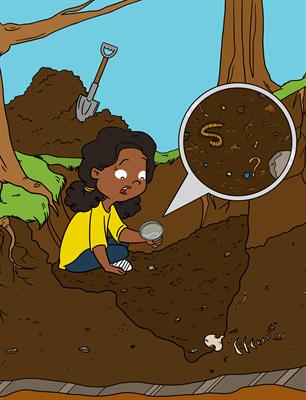
Soil biodiversity
Collection Editors
Malte Jochum, Rémy Beugnon, Helen PhillipsViews
709,177 viewsParticipating Sections
Submission Deadline
Closed
Articles

Earth Sciences
25/04/2022
How Do Plants Defend Themselves From Root-Eating...
Authors
Axel J. Touw, Nicole M. Van Dam
Earth Sciences
18/03/2022
Microbial Mats: Primitive Structures That Could...
Authors
Santiago Cadena, Paula Maza-Márquez, Sandra I. Ramírez...
Biodiversity
18/03/2022
Soil Organisms Have Favorite Forage Plants
Authors
Felicity V. Crotty
Biodiversity
16/03/2022
The Soil Fungi: A Web of Life That Protects Trees...
Authors
Olivia Azevedo, Frank Ashwood
Earth Sciences
16/03/2022
Protecting Soil Biodiversity: A Dirty Job, but...
Authors
Alberto Orgiazzi
Biodiversity
11/03/2022
The Bizarre Role of Soil Animals in the...
Authors
François-Xavier Joly, Jens-Arne Subke
Biodiversity
03/02/2022
Belowground Mountaineers: Critters Living in...
Authors
Michael Steinwandter, Julia Seeber
Biodiversity
23/11/2021
Super-Small Predators in Soils: Who Are They and...
Authors
Stefan Geisen
Biodiversity
27/10/2021
Plant-Eating Nematodes and the Key to Fighting...
Authors
Elisabeth Darling, Marisol Quintanilla-Tornel, Henry Chung
Biodiversity
22/10/2021
Having Babies in Soil: Is Sex Really Necessary?
Authors
Hüsna Öztoprak, Alexander Brandt, Marcel D. Solbach, Jens...
Biodiversity
08/10/2021
Studying the Activity of Leaf-Litter Fauna: A...
Authors
Dolores Ruiz-Lupión, María Pilar Gavín-Centol, Jordi...
Biodiversity
18/08/2021
How Soil Invertebrates Deal With Microplastic...
Authors
Carlos Barreto, Matthias C. Rillig, Walter R. Waldman...
Biodiversity
16/06/2021
Can Methane-Eating Bacteria in Drylands Help Us...
Authors
Angela Lafuente, Concha Cano-Díaz
Biodiversity
15/06/2021
From the Soil to the Club in the Roots: Clubroot
Authors
Edel Pérez-López
Biodiversity
10/05/2021
Earthworms of the World
Authors
Helen R. P. Phillips, Erin K. Cameron, Nico Eisenhauer
Biodiversity
06/05/2021
Earthworms and Their Role in Greenhouse Gas...
Authors
Pierre Ganault, Sacha Delmotte, Agnès Duhamet, Gaëlle...
Biodiversity
22/04/2021
Dung Beetles Help Keep Ecosystems Healthy
Authors
Paul Manning, Xin Rui Ong, Eleanor M. Slade
Earth Sciences
14/04/2021
Does Plant Biodiversity Influence Nutrient Cycles?
Authors
Eva Koller-France, Wolfgang Wilcke, Yvonne Oelmann
Biodiversity
11/02/2021
The Way Soil Organisms Look Can Help Us...
Authors
Pierre Ganault, Léa Beaumelle, Apolline Auclerc
Biodiversity
04/02/2021
Soil Ecosystems Change With Time
Authors
Enrique Doblas-Miranda
Biodiversity
14/01/2021
Learning More About Earthworms With Citizen...
Authors
Victoria J. Burton, Erin K. Cameron
Biodiversity
09/12/2020
How Introduced Earthworms Alter Ecosystems
Authors
Malte Jochum, Nico Eisenhauer
Biodiversity
27/11/2020
Tiny Fungi in the Soil Are Like Medicine for...
Authors
Lena Neuenkamp, Nadia I. Maaroufi
Biodiversity
24/11/2020
Springtails—Worldwide Jumpers
Authors
Anton Potapov
Biodiversity
19/11/2020
Soil Ecologists as Detectives Discovering Who...
Authors
Amandine Erktan, Melanie M. Pollierer, Stefan Scheu
Biodiversity
16/11/2020
Looking for Earthworms in Deadwood
Authors
Frank Ashwood, Elena I. Vanguelova, Sue Benham, Kevin R...
Biodiversity
13/11/2020
Bacteria in Soil Keep Your Hamburger “Healthy”
Authors
Stephanie D. Jurburg
Biodiversity
09/11/2020
Dirt Is Not Dead: How Land Use Affects the Living...
Authors
Jes Hines, Franciska T. De Vries
Biodiversity
03/11/2020
Armored Mites, Beetle Mites, or Moss Mites: The...
Authors
Carlos Barreto, Zoë Lindo
Earth Sciences
20/10/2020
The Fascinating World of Belowground Communication
Authors
Cristiana Ariotti, Elena Giuliano, Paolina Garbeva...About this collection
This Collection is the work of more than 50 scientists and Young Reviewers from all around the globe. Our role as editors, together with the authors, was to share our love of soil biodiversity with you. In this Collection, you will discover that soils are full of life. We will introduce some of the methods and techniques used by scientists to observe the life below our feet. We will show you that belowground life is essential to have healthy soils and, therefore, for us. However, you will soon realize that belowground life is changing and under multiple threats. The authors will give ideas on how we can protect soil biodiversity and invite you to actively help us in studying and protecting this valuable ecosystem. We have divided this article Collection into four sections, each of which is introduced below. To make our articles accessible to as many of you as possible, we have created a website hosting translations to languages other than English.Soils are alive
Soils are not just rock and dust but are astonishing living systems that are full of life! In this first section, you will read about little creatures that you might already know, like earthworms. You will also discover many new creatures, like springtails and mites, that live close to you in your garden, in the parks, or in nearby fields. Our authors will even show you an entire world of tiny creatures not visible by the naked eye: tiny bacteria, fungi, and protists. Soil biodiversity is about the diversity of these organisms.
But how many different organisms are there? How different are they from each other? To answer these questions, scientists need tools and methods to observe and understand the biodiversity under our feet.
How can we observe this beautiful world under our feet?
In the articles in this section, the authors describe the tools and methods they use to observe and understand soil biodiversity. It is not easy to see the creatures in the soil and what they are doing under our feet; therefore, soils are often called the "black box". Some scientists are using the body fat of soil creatures to identify them and monitor what they feed on; others use DNA to identify soil organisms, like forensic investigators in the movies. In addition, our authors will explain how soil organisms are "talking" to each other and how we study these interactions.
What are scientists learning from studying these soil creatures? Is soil biodiversity important to us?
Why is soil biodiversity so essential to us?
In this section, the authors illustrate that soil biodiversity maintains processes essential for our well-being. For example, you will learn that soil bacteria can keep your food safe by protecting it from diseases. We will highlight that soil biodiversity is essential for nature to work. For example, the authors will demonstrate that soil organisms are vital for recycling dead matter and releasing the nutrients in it. In addition, you will see how soil organisms are directly affecting greenhouse gas emissions such as carbon dioxide and methane by controlling soil processes. Controlling these emissions is critical for keeping our climate stable.
Soil organisms are alive, moving, and interacting, but are all these organisms and their important functions changing with time? Are these communities of soil organisms set in stone?
Soil communities are changing
You probably know that a lot of trees, flowers, and animals can change over the year with the seasons; flowers and fruits appear in spring and summer, leaves drop from the trees in fall. Soil animals are also changing with the seasons. And, like us, soil organisms can move to new places or disappear from others, either permanently or temporarily. These changes can be natural but can also be the result of human activities. Our authors will show you that agricultural practices and the effects of climate change (such as reduced rainfall) are affecting soil organisms, their functions, and the services they provide to us.
As we saw previously, soil biodiversity is essential for us, so any changes could be disastrous. So can we protect the organisms in the soil in the same way we protect other organisms such as tigers and pandas?
Protecting soil biodiversity
In the final section of this Collection, our authors will show you how to protect soil biodiversity. We can reduce our impacts and conserve this wonderful belowground life. But we can even go a step further and restore lost soil functions using our knowledge of soil biodiversity; for example by using fungi to restore soils. However, this is only possible if we understand soil biodiversity and its function. This is where you can help, for example by participating in a citizen science project and going outside to help researchers.
Conclusion
This Collection is about illuminating the "black box" of soil and showing you some of the fantastic creatures living under our feet. You will learn how scientists are studying soil biodiversity and how this soil biodiversity is essential for us. However, you will also see that soil biodiversity is under threat and needs to be protected. Many people across the globe will be needed to effectively protect these vital systems below our feet. That’s why it is important to spread the word about the beauty and fragility of belowground life. We hope that this Collection will make you a champion of soil biodiversity and that you will pass on this message so that everyone will become more aware of, and be better able to protect soil biodiversity.
Now it is your turn to explore and engage with the content of this Collection. We hope there will be something for all of you!
Would you like to submit to this collection?
For researchers interested in submitting to this Collection, please consult our author guidelines and check that you have all the essentials included before submitting
Editorial Board
Collection Editors
Science Mentors

Rita Araujo

Cristiana Ariotti

Gary Bates

Francesco Catania

Lynette Cheah

Christopher Emerling

Luisa Falcon

Daniel Garza

Anna Klamerus-Iwan

Suhas Kumar

Jessica Lee

Nina Markham

Maskit Maymon

Irina Moshkova

Fares Najar

Salza Palpurina

Shruti Parikh

Vinuselvi Parisutham

M. Nils Peterson

Sreenivas Ravella

Nicole Ricker

Julia Rittenschober

Joyce Sakamoto

Patricia Saleeby

Kirsty Salmon

Maria Segovia-Salcedo

Ruchira Sharma

Hannah Simba

Tom Vercauteren

Ryan Weir


